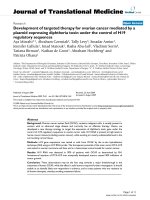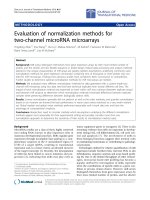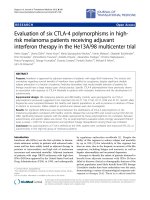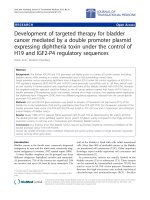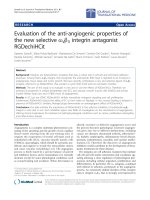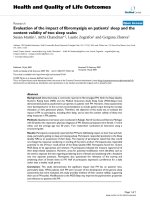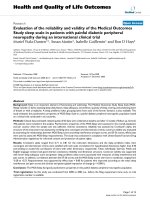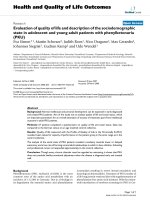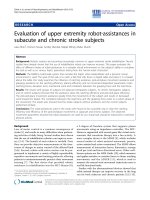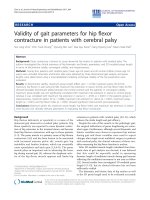Báo cáo hóa học: " Evaluation of normalization methods for two-channel microRNA microarrays" ppt
Bạn đang xem bản rút gọn của tài liệu. Xem và tải ngay bản đầy đủ của tài liệu tại đây (368.01 KB, 7 trang )
METH O D O LOG Y Open Access
Evaluation of normalization methods for
two-channel microRNA microarrays
Yingdong Zhao
1†
, Ena Wang
2†
, Hui Liu
2
, Melissa Rotunno
3
, Jill Koshiol
3
, Francesco M Marincola
2
,
Maria Teresa Landi
3*
, Lisa M McShane
1*
Abstract
Background: MiR arrays distinguish themselves from gene expression arrays by their more limited number of
probes, and the shorter and less flexible sequence in probe design. Robust data proc essing and analysis methods
tailored to the unique characteristics of miR arrays are greatly needed. Assumptions underlying commonly used
normalization methods for gene expression microarrays containing tens of thousands or more probes may not
hold for miR microarrays. Findings from previous studies have sometimes been inconclusive or contradictory.
Further studies to determine optimal normalization methods for miR microarrays are needed.
Methods: We evaluated many different normalization methods for data generated with a custom-made two
channel miR microarray using two data sets that have technical replicates from several different cell lines. The
impact of each normalization method was examined on both within miR error variance (between replicate arrays)
and between miR variance to determine which normalization methods minimized differences betw een replicate
samples while preserving differences between biologically distinct miRs.
Results: Lowess normalization generally did not perform as well as the other methods, and quantile nor malization
based on an invariant set showed the best performance in many cases unless restricte d to a very small invariant
set. Global median and global mean methods performed reasonably well in both data sets and have the
advantage of computational simplicity.
Conclusions: Researchers need to consider carefully which assumptions underlying the different normalization
methods appear most reasonable for their experimental setting and possibly consider more than one
normalization approach to determine the sensitivity of their result s to normalization method used.
Background
MicroRNAs (miRs) are a class of short, highly conserved
non-coding RNAs known to pla y important roles in
numerous developmental processes. MiRs regulate gene
expression through i ncomplete base-pairing to a com-
plementary sequence in the 3′ untranslated region (3′
UTR) of a target mRNA, resu lting in translational
repression and, to a lesser extent, accelerated turnover
ofthetargettranscript[1].Recently, the dysregulation
of miRs has been linked to cancer initiation and pro-
gression [2 ], indicating that miRs may play roles as
tumor suppressor genes or oncogenes [3]. There is also
mounting evidence that miRs are important in develop-
ment timing [4,5], cell differentiation [6], cell cycle con-
trol and apoptosis [7]. The involvement of miRs in
those biological functions suggests their intrinsic roles
in maintaining homeostasis or contributing to pathologi-
cal processes.
Technologies utilized for relative quantification of miR
expression include Northern blot, real time PCR, in situ
hybridization, sequence analysis and a rray-based profil-
ing [8]. Due to the limited throughput of other technol-
ogies, microarray-based miR profiling has become a
popular method for interrogation of miRs, especially
when the contributions of specific miRs to a given con-
dition or process remain elusive. However, miR arrays
distinguish themselves from gene expression arrays by
their more limited number of probes, and the shorter
* Correspondence: ;
† Contributed equally
1
Division of Cancer Treatment and Diagnosis, National Cancer Institute,
National Institutes of Health, Bethesda, Maryland, USA
3
Division of Cancer Epidemiology and Genetics, National Cancer Institute,
National Institutes of Health, Bethesda, Maryland, USA
Zhao et al . Journal of Translational Medicine 2010, 8:69
/>© 2010 Zhao et al; licensee BioMed Central Ltd. This is an Open Access article distributed under the terms of the Creative Commons
Attribution License (http://creativecomm ons.org/licenses/b y/2.0), which permits unr estricted use, distribution, and reproduction in
any medium, provided the original work is properly ci ted.
and less f lexible sequence in probe design. Robust data
processing and analysis methods tailored to t he unique
characteristics of miR arrays are greatly needed.
Normalization is a key early step in miR microarray
data processing. Normalization methods are aimed at
removing data artifacts resulting from systematic or ran-
dom technical variation. If not removed, these artifacts
might affect subsequent data analyses, such as class
comparison and class predic tion. Assumptions underly-
ing commonly used normalization methods for gene
expression microarrays containing tens of thousands or
more probes may not hold for miR microarrays. Further
studies to determine optimal normalization methods for
miR microarrays are needed. The best normalization
method may differ depending on whether the miR chip
uses a one-channel or two-channel system. In a one
channel system, single samples are labeled and hybri-
dized to individual arrays. For arrays using a two-chan-
nel system , generall y two samples are separately labeled,
mixed, and hybridized tog ether to each array. The most
commonly used design for a two-channel system is
called the reference design. One of the samples is used
as an internal standard so that the signal intensity which
reflects the amount of hybridization to a probe for a
sample of interest is measured relative to the intensity
for the same probe on the same array for the reference
sample [9].
Several papers comparing miR microarray normaliza-
tion methods have been published; however, the results
and recommendations are not consistent. Rao et al [10]
compared normalization methods for single channel
miR microarray data. They reported that quantile nor-
malization was the best performing method for reducing
the differences in micro RNA expression values among
replicate tissue samples . Pradervand et al. [11] con-
firmed that quantile normalization was the most robust
normalization method for their set of invariant miRs
using the Agilent single channel platform. In contrast,
Hua et al. [12], using Rt-PCR as a gold standard, found
that the lowess method gave the best result for two-
channel miR microarray data, although the differences
among their top performing methods were minimal.
However, the suitability of Rt-PCR as a comparator for
miR microarray expression results has been questioned
[8,13], and the stability of lowess smoothers is known to
be dependent on the number of data points to which
they are applied. Sarkar et al. [14] reported quality
asse ssment for two- channel miR expression array s, and
they found that all normalization methods performed
adequately in their study.
Here we report our evaluation of many different nor-
malization methods on a custom-made two channel
miR microarray. Our study examined technical repli-
cates from a large number of different cell lines to
determine which normalization methods minimized
differences between replicate samples while preserving
differences between biologically distinct miRs.
Methods
Cell line culture
Ten lung carcinoma cell lines from the NCI60 panel
were obtained from the Nat ional Cancer Institute’ s
Developmental Therapeutics Program (DTP), and 9
renal cell carcinoma cell lines were generated at the
Surgery Branch, National Cancer Institute, National
Institutes of Health (NIH). All cell lines were cultured
in complete RPMI media supplemented with 10% FBS,
1 mM H EPES, 1 mM Ciprofloxacin and L-glutamine/
penicillin/streptomycin. All cells were cultured at 37°C
under 5% CO
2
. Cells were harvested at sub-confluent
condition by trypsin-versene (Invitrogen) detach ment
and centrifugation after 3-5 days in culture. A single
EBV cell line used as the reference sample was cultured
in the same media in suspensional growth cells and har-
vested by centrifugation at 120 0 rpm for 5 min after
one week of culture. Cell pellets were immediately lysed
in Trizol at 1-2e7 cell per ml of Trizol.
RNA isolation and labeling
Total RNA from 10 lung carcinoma cell lines and 9
renal cell carcinoma cell lines were isolated using T rizol
reagent. Small RNA in total RNA samples were enriched
and p urified by flashPAGE Fractionator (Ambion, Aus-
tin, TX USA) according to the manufacturer’ sinstruc-
tion. The re ference sample consisting of one EBV cell
line was processed followin g identical procedures. After
small RNA purification, small RNA from test samples
and EBV reference samples, equivalent to 10 μgofthe
total RNA, were labeled with Cy5 and Cy3, respectively,
using mirVana™ miRNA Labeling Kit (Ambion, Austin,
TX USA).
Microarray fabrication and quality control procedures
A custom-made oligo array including 714 human, mam-
malian and viral mature antisens e miRs (mirbase: http://
microrna.sanger.ac.uk/, version9.1) plus 2 internal con-
trols with 7 serial dilutions [2,6,15] were printed at
Infectious Disease and Immunogenetics Section, Depart-
ment of Transfusion Medicine, Clinical Center, NIH.
TheantisensemiRoligoprobeswere5′ amine modified
and immobilized in duplicate (two spots per miR per
array) on CodeLink activated slides (GE Health, NJ,
USA) via covalent binding. Serially diluted control
probes were used as indicators of labeling efficiency,
optimization of intensity saturation, and intensity bal-
ance of test vs. reference sample. A single large labeling
reaction of the EBV reference samples was used for all
arrays. Strong and positive EBV-miR hybridization also
Zhao et al . Journal of Translational Medicine 2010, 8:69
/>Page 2 of 7
functioned as a positive control quality assessment of
the reference sample.
Sample hybridization and image analysis
Equal amounts of labeled test and reference samples
were cohybridized on the custom made miR oligo
microarray for more than 14 hours at room te mpera-
ture. After washing, the array was scanned using a Gen-
ePix 4B scanner. Any s pot smaller than 25 pixels was
filtered out and excluded from remaining analyses. If
both channels produced intensities less than 100 for a
given microRNA, that spot was also filtered out. For
spots with one channel i ntensity less than 100 but the
other channel intensity 100 or greater, the signal less
than 100 was set to 100 prior to calculation of the signal
ratio. The intensity ratio for each spot was then calcu-
lated as the red signal intensity (test samples) divided by
the green channel s ignal intensity (EBV referen ce sam-
ples). Both single channel intensities and int ensity ratios
were log transformed (base 2) for normalization and
further analyses. Overall, 9 out of 10 lung carcinoma
cell lines and all 9 renal cell carcinoma cell lines have
duplicate samples while one lung carcinoma cell li nes
has quadruplicate samples.
Normalization Methods
1) Median
This normalization method uses the gl obal median
of log intensity ratios on each chip as the norm aliza-
tion factor. The global median log intensity ratio is
calculated across all spots on the chip, and then this
value is subtracted from the log intensity ratio for
each spot. The global median of the normalized log
intensity ratios equals zero.
2) Mean
This normalization method uses the global mean of
log intensity ratios on each chip as the normalization
factor. The global mean log intensity ratio is calcu-
lated across all spots o n the chip, and then this
value is subtracted from the log intensity ratio for
each spot. The global mean of the normalized log
intensity ratios equals zero.
3) Trimmed Mean
This normalization method is similar to the mean
normalization method except that a trimmed mean
of log intensity ratios on each chip is used as the
normalization factor in place of the over all mean. A
trimmed mean is calculated by discarding a certain
percentage of the lowest and the highest log inten-
sity ratios and then computing the mean of the
remaining log intensity values. It is less susceptible
to the effects of extreme values. In our experiments,
we used a trimming percentage of 1% from both the
lowest and highest data values.
4) Lowess
Lowess normalization assumes that the dye bias
might be dependent on spot intensity. Let (logG,
logR) be the green and red background-corrected log
intensities. Then, (M, A)aredefinedbyM = log(R/
G)and
ARG=
1
2
log( )
. Note that M is the unnor-
malized log ratio.
The adjusted log ratio for the jth miR is computed
by: M
j
*(A
j
)=M
j
-c(A
j
), where c(A
j
)isthelowess
curve fit to the MA plot. For the calculations pre-
sented in this paper, the lowess curve was calculated
using the R function loess with a span set at 0.5 [16].
5) Quantile-quantile
Quantile normalization [ 17] assumes that the distri-
bution of miR abundances is nearly the same in all
samples. For conveni ence, an artificial reference chip
is created by pooling intensities across all chips in
the experiment to produce an intensity reference
distribution. This reference distribution is described
by a distribution function F
2
.Tonormalizeeach
chip, the distribution of miR intensities for t hat chip
(e.g. deno ted by the distribution function F
1
)is
transformed to equal the reference intensity distribu-
tion. Operationally, this transformation is accom-
plished by determining for each signal intensity on
the chip its quantile in the chip’ s intensity distribu-
tion and replacing that value with the value having
that quantile in the reference distribution. In a for-
mula, the transform is
x
norm
=F
2
-1
(F
1
(x)),
where F
1
is the distribution function of the actual
chip, and F
2
is the distributi on function of the refer-
ence chip.
6) Invariant set option
Sometimes the normalization factors or curves cal-
culated as described above are derived using only an
invariantsubsetoftheprobes(e.g.,miRs).The
notion of invariant set norma lization was first intro-
duced for Affymetrix gene expression chips [18], but
it can be generalized to miR arrays. This method
assumes that there is a set of reference miRs that
are invariant across a set of samples. Rather than
requiring apriorispecification of a standard set of
“housekeeping miRs”, the invariant set i s determined
empirically. The invariant probes are identified by
determining those probes which have most similar
rank order a cross all arrays as measured by the
smallest variance of ranks. There is some arbitrari-
ness in deciding what percentage of the probes
belong in the invariant set, so in our study we con-
sidered several possible percentages, i ncluding 10%,
20%, 30% and 40% of the probes with the smallest
variance to serve as the “invariant set”.Normaliza-
tionmethods1)to5)werethenreappliedbasedon
Zhao et al . Journal of Translational Medicine 2010, 8:69
/>Page 3 of 7
the d efined invariant sets of miRs. The invariant set
of miRs i ncluding 40% of the probes with smallest
variance was used only for the quantile normaliza-
tion method.
The shorthand notation used to indicate the various
normalization methods is the name of the main
approach (Median, Mean, trimmed Mean, Lowess,
or Quantile) with a suffix indicating the size of the
invariant set used, if any (.10,.20,.30,.40). No suffix
indicates that the full set of miRs was used.
Measures of variation
We examined the impact of each normalizati on method
on both within miR error variance (between replicate
arrays) and between miR variance. This analysis was
based on a components of variance model:
Yme
ij i ij
=+
where Y
ij
denotes the log transformed intensity ratio
of ith miR in the jth replicate. The error variance co m-
ponent
σ
e
2
associated with e
ij
(technical error) repre-
sents the reproducibility of the method. The variance
component
σ
m
2
associated with m
i
(true miR expression)
represents the true miR-to-miR variability. Formulas for
computing the variance components and intra-class cor-
relation based on method-of-moments estimation for
each cell line under each normalization method can be
computed as in Korn et al. [19]. The error variance
(within-miR) variance component is estimated by
∧
=− −
==
∑∑
e
ij i m a
j
n
i
n
YY nn
am
2
2
11
1()/[()]
.
where n
a
= number of replicate arrays, n
m
=number
of miRs and
YYn
iija
j
n
a
.
/=
=
∑
1
The between-miR variance component is estimated by
∧∧
=− −−
=
=
=
∑
m
i
i
n
m
e
a
ij m a
j
n
YY n n
YYnn
m
2
1
2
2
1
1()/()/
/(
where
aam
i
n
∑∑
=1
)
The estimated intra-class correlation (ICC)foreach
cell line is
ICC
mme
=+
∧∧∧
222
/( )
and it e stimates the proportion of th e total variance
(sum of within and between miR variances) due to the
between miR variance. It is desirable for the ICC to be
large (close to one), indicating that the technical error
variance is relatively small compared to biological differ-
ences between miRs [19]. When the error variance is
fairly high, it is possible for the estimated ICC to be
negative due to use of method-of-moments estimation,
especially when the number of technical replicates is
small. The advantage of the method-of-moments esti-
mators is that they are unbiased and simple to compute.
Statistical tests for differences in ICC between
normalization methods
We examined the following normalization m ethods: no
normalization, mean, median, trimmed mean, lowess
and quantile normalization based on a ll miRs (N = 6
normalization methods); based on the three invariant
sets defined above for the mean, median, trimm ed
mean, and lowe ss methods (N = 12); and based on four
invariant sets for the quantile method (N = 4). For each
of these normalization methods, there were 19 ICC
values computed, corresponding to 10 lung cancer cell
lines and 9 renal cancer cell lines. Separately for the
lung cancer cell lines and the renal cancer cell lines,
Wil coxon signed-rank tests were applied to the ICC for
each of the 231 possible pairings of these methods. Two
methods were considered statistically significantly differ-
ent if the 2-sided p-value from the signed-rank test was
less than a =0.01.Thisa level was chosen so that the
expected number of false positive differences would be
no more than 3 among the 231 paired tests for each of
the two cell line experiments.
Results
The ICCs for different normalization methods using the
ten lung cancer cell lines ranged from -0.30 to 0.87 (see
Table1,2andFigure1).Thequantilenormalization
methods based on invariant sets were observed to pro-
duce the highest mean ICCs across the ten lung cancer
cell lines (mean ICC > 0.60, for all invariant set sizes
10-40%). The worst performing methods were the low-
ess methods when based on invariant sets (mean ICC <
0.50). For all pairwise compariso ns of invariant set
quantile normalization versus invariant set lowess nor-
malization, the distribution of ICCs was significantly
lower for the lowess-based methods compared to the
quantile-based methods (P < 0.01 for all pairs, Wilcoxon
signed rank tests). Cell line effects were also a pparent,
with the lowest average ICC observed for cell line 1
Zhao et al . Journal of Translational Medicine 2010, 8:69
/>Page 4 of 7
(mean ICC = 0.02, empty blue circle in Figure 1) and
the highest avera ge ICC observed for cell line 3 (mean
ICC = 0.84, empty green square in Figure 1). When
using the full data set (not restricting to an invariant
set), global mean, global trimmed-mean, and global
median performed about equally well, although those
ICCs were somewhat lower than the ICCsforthequan-
tile-based methods using invaria nt sets. With the excep-
tion of the lowess methods and methods using small
invariant sets (e.g., 10%), performing some type of nor-
malization generally produced higher ICCsthanper-
forming no normalization.
The ICCs for different normalization methods for the
experiment involving nine renal cancer cell lines ranged
from 0.66 to 0.96 (see Table 3, 4 and Figure 2). Overall,
the ICCs were higher for the renal cell lines than for the
lung cancer cell lines, likely due to the more controlled
setting in which the renal cancer cell lines were pro-
cessed, although it is possible that biological differences
between the lung and renal cell lines could also partly
explain the findings. The entire set of renal cancer cell
line experiments was performed in one flash page batch
by one technician, in contrast to the lung cancer cell
line experiments, which were processed in several
batches. Whe n using the full set of miRs for normaliza-
tion, the mean, trimmed mean, and median normaliza-
tion methods all produced similarly high ICCs. As was
observed for the lung cancer cell line experiments, the
lowess methods based on invariant sets tended to p ro-
duce lower ICC s and the quantile methods based on
invariant sets tended to produce higher ICCs. Compar-
ing invariant set quantile normalization to invariant set
lowess normalization, ICCs were always observed to be
lower for the lowess-based methods compared to the
quantile-based methods with the pairwise differences
reaching statistical significance for most pairs (P < 0.01
for most pairs, Wilcoxon s igned rank tests) [Additional
Table 1 Summary statistics for performance of different
normalization methods based on intra-class correlations
(ICCs) computed for replicate miR microarray data
obtained using 10 different lung cancer cell lines
Methods Min Max Median Mean SD
No.Norm -0.03 0.82 0.55 0.51 0.25
Mean -0.02 0.87 0.58 0.56 0.27
t.Mean -0.02 0.87 0.58 0.56 0.27
Median -0.06 0.87 0.56 0.54 0.27
Lowess 0.05 0.87 0.51 0.53 0.26
Quantile 0.17 0.78 0.54 0.52 0.18
Mean.10 -0.15 0.84 0.38 0.36 0.36
Mean.20 -0.05 0.86 0.55 0.54 0.28
Mean.30 -0.03 0.87 0.56 0.55 0.27
t.Mean.10 -0.15 0.84 0.38 0.36 0.36
t.Mean.20 -0.05 0.86 0.55 0.53 0.28
t.Mean.30 -0.02 0.87 0.56 0.55 0.27
Median.10 -0.21 0.86 0.36 0.35 0.39
Median.20 -0.11 0.87 0.56 0.54 0.29
Median.30 -0.07 0.87 0.57 0.55 0.28
Lowess.10 -0.30 0.73 0.16 0.23 0.35
Lowess.20 -0.06 0.85 0.37 0.42 0.30
Lowess.30 0.02 0.87 0.44 0.48 0.28
Quantile.10 0.24 0.86 0.62 0.60 0.20
Quantile.20 0.39 0.87 0.67 0.65 0.16
Quantile.30 0.38 0.85 0.63 0.62 0.18
Quantile.40 0.34 0.86 0.65 0.62 0.18
Table 2 Summary statistics for 10 different lung cancer
cell lines based on intra-class correlations (ICCs)
computed for replicate miR microarray data processed
using different normalization methods
Cell lines Min Max Median Mean SD
1 -0.21 0.39 -0.03 0.02 0.17
2 -0.30 0.59 0.33 0.26 0.24
3 0.72 0.87 0.85 0.84 0.04
4 0.13 0.50 0.40 0.39 0.07
5 0.18 0.64 0.59 0.53 0.13
6 -0.05 0.71 0.53 0.46 0.19
7 0.47 0.77 0.67 0.66 0.07
8 -0.01 0.55 0.46 0.38 0.18
9 0.60 0.76 0.74 0.73 0.05
10 0.60 0.87 0.85 0.82 0.07
Figure 1 DotplotforcomparisonofICCsobservedfor
different normalization methods applied to replicate miR
microarray data from 10 lung cancer cell lines. The y axis is the
intra-class correlation coefficient (ICC), and the x-axis lists different
normalization methods. The x-axis indicates the normalization
method used. The shorthand notation for the normalization method
is the name of the main approach (Median, Mean, trimmed Mean,
Lowess, or Quantile) with a suffix indicating the size of the invariant
set used, if any (.10,.20,.30,.40). No suffix indicates that the full set of
miRs was used.
Zhao et al . Journal of Translational Medicine 2010, 8:69
/>Page 5 of 7
file 1, 2]. With the exception of the lowess metho d
based on 10% invariant set, performing some type of
normalization produced a higher ICC than performing
no normalization at all.
Discussion
Data normalization is an important step in the analysis
of microarray data. We explored a comprehensive col-
lection of normalization methods in miR microarray
experiments using lung cancer cell lines and renal
cancer cell lines to address the question of which nor-
malization methods might be most appropriate for miR
microarray data. We tested global mean, trimmed mean,
global median, lowess, and quantile-quantile methods
and examined the impact of using each of these meth-
ods restricted to an empirically determined invariant
miR set. We found that for our data sets, lowess nor-
malization generally did not perform as well a s the
other methods. For the lung cancer cell lines quantile
normalization applied to an invariant set was best on
average unless restricted to a very small invariant set
(e.g., 10%). Quantile normalization with invariant set
also performed well for the renal cancer cell line s, but
average observed ICCs were slightly higher for global
median and mean methods. The good performance of
quantile normalization restricted to an invariant miR set
observed in our study i s consistent with a previous
study reported for a one channel miR chip [11 ]. Global
median and global mean methods perform ed reasonably
well in both data sets and have the advantage of compu-
tational simplicity.
Although many different nor malization methods have
been used for gene expression microarray data, there may
be characteristics of miR expression that will influence the
optimal choice of normalization method for miR microar-
ray data. The number of probes on a miR microarray is
typically much smaller (a few hundred or less) than the
number of probes on a gene expression cDNA microarray
Table 4 Summary statistics for 9 different renal cancer
cell lines based on intra-class correlations (ICCs)
computed for replicate miR microarray data processed
using different normalization methods
Cell lines Min Max Median Mean SD
1 0.91 0.96 0.95 0.95 0.01
2 0.84 0.95 0.94 0.93 0.03
3 0.89 0.94 0.93 0.93 0.01
4 0.75 0.92 0.91 0.90 0.03
5 0.66 0.90 0.90 0.88 0.05
6 0.89 0.94 0.93 0.93 0.02
7 0.76 0.91 0.90 0.89 0.03
8 0.90 0.95 0.95 0.94 0.01
9 0.92 0.93 0.93 0.93 0.00
Table 3 Summary statistics for performance of different
normalization methods based on intra-class correlations
(ICCs) computed for replicate miR microarray data
obtained using 9 different renal cancer cell lines
Methods Min Max Median Mean SD
No.Norm 0.66 0.95 0.91 0.89 0.09
Mean 0.90 0.96 0.94 0.93 0.02
t.Mean 0.90 0.96 0.94 0.93 0.02
Median 0.90 0.96 0.94 0.93 0.02
Lowess 0.87 0.95 0.91 0.91 0.03
Quantile 0.88 0.94 0.92 0.91 0.02
Mean.10 0.90 0.95 0.93 0.93 0.02
Mean.20 0.90 0.96 0.93 0.93 0.02
Mean.30 0.90 0.96 0.94 0.93 0.02
t.Mean.10 0.90 0.95 0.93 0.93 0.02
t.Mean.20 0.90 0.96 0.93 0.93 0.02
t.Mean.30 0.90 0.96 0.94 0.93 0.02
Median.10 0.90 0.95 0.93 0.93 0.02
Median.20 0.90 0.95 0.93 0.93 0.02
Median.30 0.90 0.95 0.94 0.93 0.02
Lowess.10 0.75 0.92 0.89 0.86 0.06
Lowess.20 0.86 0.94 0.90 0.90 0.03
Lowess.30 0.87 0.95 0.90 0.91 0.03
Quantile.10 0.89 0.94 0.92 0.92 0.02
Quantile.20 0.89 0.95 0.93 0.92 0.02
Quantile.30 0.90 0.95 0.93 0.92 0.02
Quantile.40 0.89 0.95 0.93 0.92 0.02
Figure 2 DotplotforcomparisonofICCsobservedfor
different normalization methods applied to replicate miR
microarray data from 9 renal cancer cell lines. The y axis is the
intra-class correlation coefficient (ICC), and the x-axis lists different
normalization methods. The x-axis indicates the normalization
method used. The shorthand notation for the normalization method
is the name of the main approach (Median, Mean, trimmed Mean,
Lowess, or Quantile) with a suffix indicating the size of the invariant
set used, if any (.10,.20,.30,.40). No suffix indicates that the full set of
miRs was used.
Zhao et al . Journal of Translational Medicine 2010, 8:69
/>Page 6 of 7
(usually tens of thousand s), and the expect ed p roportion
of differentially expressed miRs comparing across samples
in a miR microarray experiment might be higher than the
proportion of differentially expressed genes typically
expected for gene expression microarray studies. It may be
difficult to anticipate what percentage of miRs are likely to
be truly invariant across a set of samples used in an
experiment, so ad hoc decisions may have to be made for
the invariant set size to be used for normalization methods
that use invariant sets. Our results suggested that using an
invariant set consisting of only 10% of the miRs resulted in
diminished performance compared to methods using lar-
ger invariant sets, but the appropriate invariant s et size
obviously could depend on the particular experimental
setting. Global mean and median methods require
assumptions that either the number of differentially
expressed miRs is not too large or that the amount of
over-expression and under-expression of miRs within each
sample is somehow balanced so that the mean or median
is still a reasonable indicator of overall shift in expression
level due to technical factors. Researchers still need to
consider carefully which assumptions underlying the dif-
ferent normalization methods appear most reasonable for
their experimental setting and possibly consider more
than one normalization approach to determine the sensi-
tivity of their results to normalization method used.
Additional material
Additional file 1: Table presenting p-values resulting from Wilc oxon
signed-rank tests used to compare ICCs of different normalization
methods applied to data obtained by miR microarray analysis of 10
lung cancer cell lines.
Additional file 2: Table presenting p-values resulting from Wilc oxon
signed-rank tests used to compare ICCs of different normalization
methods applied to data obtained by miR microarray analysis of 9
renal cancer cell lines.
Author details
1
Division of Cancer Treatment and Diagnosis, National Cancer Institute,
National Institutes of Health, Bethesda, Maryland, USA.
2
Department of
Transfusion Medicine, Clinical Center, National Institutes of Health, Bethesda,
Maryland, USA.
3
Division of Cancer Epidemiology and Genetics, National
Cancer Institute, National Institutes of Health, Bethesda, Maryland, USA.
Authors’ contributions
YZ, EW, MTL, and LMM conceived of the study. YZ and LMM proposed the
experimental design with input from EW, MTL, FMM, MR, and JK. EW and LH
performed the miR array experiments. YZ performed the statistical analyses
with input from LMM. YZ, EW, and LMM drafted the manuscript. All authors
read and approved the final version of the manuscript.
Competing interests
The authors declare that they have no competing interests.
Received: 17 March 2010 Accepted: 21 July 2010
Published: 21 July 2010
References
1. Valencia-Sanchez MA, Liu J, Hannon GJ, Parker R: Control of translation
and mRNA degradation by miRNAs and siRNAs. Genes Dev 2006,
20(5):515-524.
2. Landi MT, Zhao Y, Rotunno M, Koshiol J, Liu H, Bergen AW, Rubagotti M,
Goldstein AM, Linnoila I, Marincola FM, Tucker MA, Bertazzi PA, Pesatori AC,
Caporaso NE, McShane LM, Wang E: MicroRNA expression differentiates
histology and predicts survival of lung cancer. Clinical Cancer Research
2010, 16:430-441.
3. Esquela-Kerscher A, Slack FJ: Oncomirs - microRNAs with a role in cancer.
Nat Rev Cancer 2006, 6(4):259-269.
4. Abbott AL, Alvarez-Saavedra E, Miska EA, Lau NC, Bartel DP, Horvitz HR,
Ambros V: The let-7 MicroRNA family members mir-48, mir-84, and mir-
241 function together to regulate developmental timing in
Caenorhabditis elegans. Dev Cell 2005, 9(3):403-14.
5. Nimmo RA, Slack FJ: An elegant miRror: microRNAs in stem cells,
developmental timing and cancer. Chromosoma 2009, 118(4):405-18.
6. Ren J, Jin P, Wang E, Marincola FM, Stroncek DF: MicroRNA and gene
expression patterns in the differentiation of human embryonic stem
cells. J Transl Med 2009, 7:20.
7. Hermeking H: The miR-34 family in cancer and apoptosis. Cell Death Differ
2009, 17:193-9.
8. Koshiol J, Wang E, Zhao Y, Marincola F, Landi MT: Strengths and
limitations of laboratory procedures for microRNA detection. Cancer
Epidemiology, Biomarkers & Prevention 2010, 19:907-11, [7].
9. Simon R, Korn EL, McShane LM, Radmacher MD, Wright G, Zhao Y: Design
and Analysis of DNA Microarray Investigations. New York: Springer Verlag
2004.
10. Rao Y, Lee Y, Jarjoura D, Ruppert AS, Liu CG, Hsu JC, Hagan JP: A
comparison of normalization techniques for microRNA microarray data.
Stat Appl Genet Mol Biol 2008, 7(1), Article22.
11. Pradervand S, Weber J, Thomas J, Bueno M, Wirapati P, Lefort K, Dotto GP,
Harshman K: Impact of normalization on miRNA microarray expression
profiling. RNA 2009, 15:493-501.
12. Hua YJ, Tu K, Tang ZY, Li YX, Xiao HS: Comparison of normalization
methods with microRNA microarray. Genomics 2008, 92(2):122-8.
13. Chen Y, Gelfond JAL, McManus LM, Shireman PK: Reproducibility of
Quantitative RT-PCR Array in miRNA Expression Profiling and
Comparison with Microarray Analysis. BMC Genomics 2009, 10:407.
14. Sarkar D, Parkin R, Wyman S, Bendoraite A, Sather C, Delrow J, Godwin AK,
Drescher C, Huber W, Gentleman R, Tewari M: Quality assessment and
data analysis for microRNA expression arrays. Nucleic Acids Res 2009,
37(2):e17.
15. Jin P, Wang E, Ren J, Childs R, Shin JW, Khuu H, Marincola FM, Stroncek DF:
Differentiation of two types of mobilized peripheral blood stem cells by
microRNA and cDNA expression analysis. J Transl Med 2008, 6:39.
16. Cleveland WS: Robust Locally Weighted Regression and Smoothing
Scatterplots. Journal of the American Statistical Association 1979,
74(368):829-836.
17. Bolstad BM, Irizarry RA, Astrand M, Speed TP: A Comparison of
Normalization Methods for High Density Oligonucleotide Array Data
Based on Bias and Variance. Bioinformatics 2003, 19(2):185-193.
18. Li C, Wong WH: Model-based analysis of oligonucleotides arrays: model
validation, design issues and standard error application. Genome Biology
2001, 2(8):research0032.1-0032.11.
19. Korn EL, Habermann JK, Upender MB, Ried T, McShane LM: Objective
method of comparing DNA microarray image analysis systems.
BioTechniques 2004, 36(6):960-7.
doi:10.1186/1479-5876-8-69
Cite this article as: Zhao et al.: Evaluation of normalization methods for
two-channel microRNA microarrays. Journal of Translational Medicine 2010
8:69.
Zhao et al . Journal of Translational Medicine 2010, 8:69
/>Page 7 of 7
